
21 minute read
LIFE ON THE INTERNATIONAL SPACE STATION
BY CRAIG COLLINS
When NASA astronaut Cady Coleman approached the International Space Station in a Soyuz capsule on Dec. 17, 2010, she wasn’t a wide-eyed, awestruck fledgling. In previous missions aboard the space shutBY CRAIG COLLINS tle Columbia, she’d traveled 6 million miles in orbit. She knew as much about the station as anyone, and she’d spent years training as a contingency spacewalker – an astronaut ready to go outside the station to solve an unforeseen problem – submerged in the pool known as the Neutral Buoyancy Laboratory (NBL) at the Johnson Space Center in Houston, servicing underwater replicas of station modules. Coleman, who retired from NASA in 2016, said the models were a little corroded and showing their age. “Everything was kind of worn and beaten,” she said.
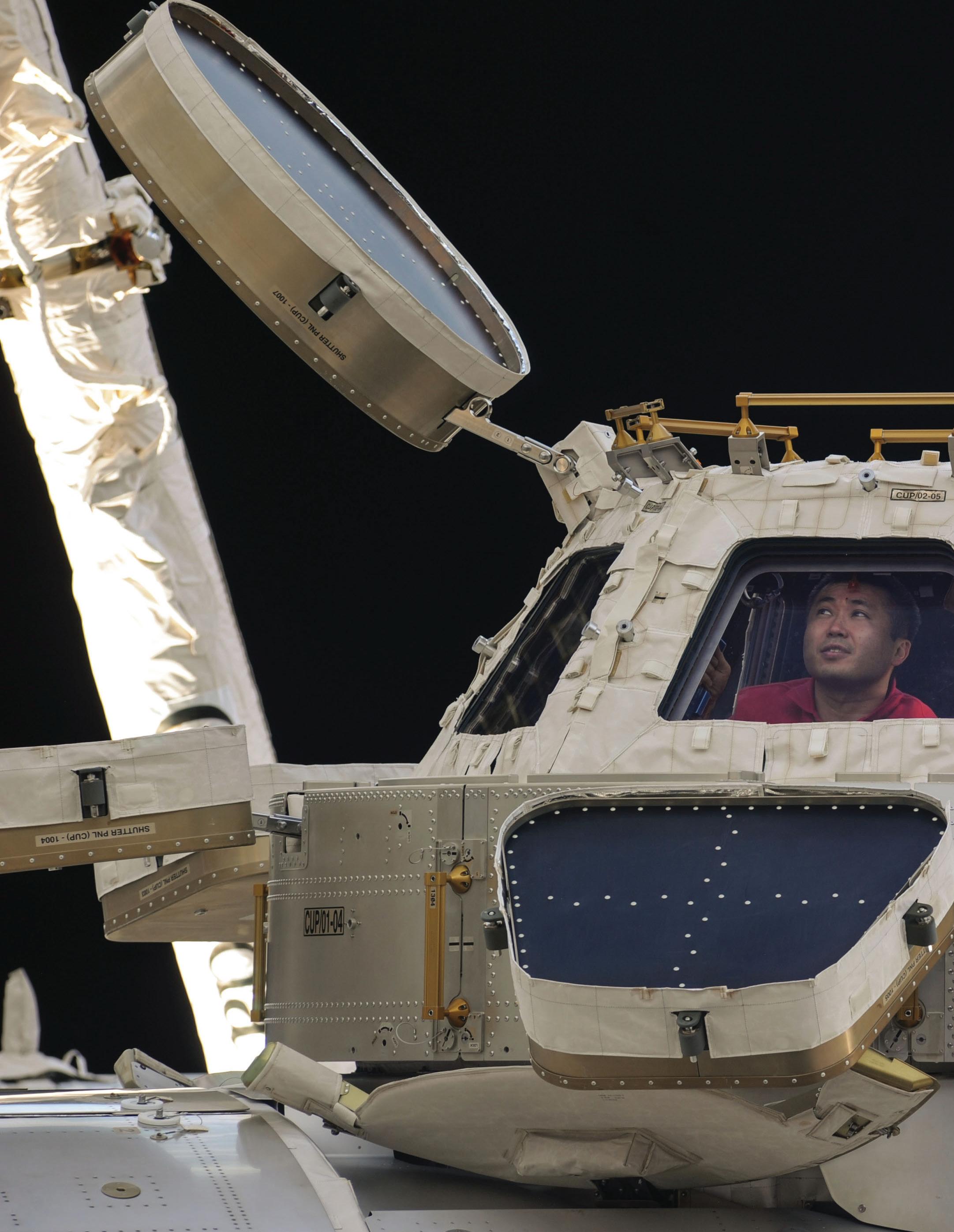
Expedition 39 Commander Koichi Wakata of the Japan Aerospace Exploration Agency (JAXA) peers out of one of the windows of the cupola on the Earth-orbiting International Space Station. A crewmate inside the Pirs docking module recorded the image.
Astronauts often describe the experience of finally understanding something they thought they’d already known – and for Coleman this happened before she’d unfastened her Soyuz seatbelt. She’d seen the International Space Station in photos and videos, and on control room consoles. But nothing had prepared her for the sight of the 12-year-old station through her spacecraft window: gleaming, spotless, as if it were brand new. “As our Soyuz approached,” she recalled, “here was this pristine, beautiful station. I just remember the delight of thinking: ‘Wow. I’m really here. This is it.’”
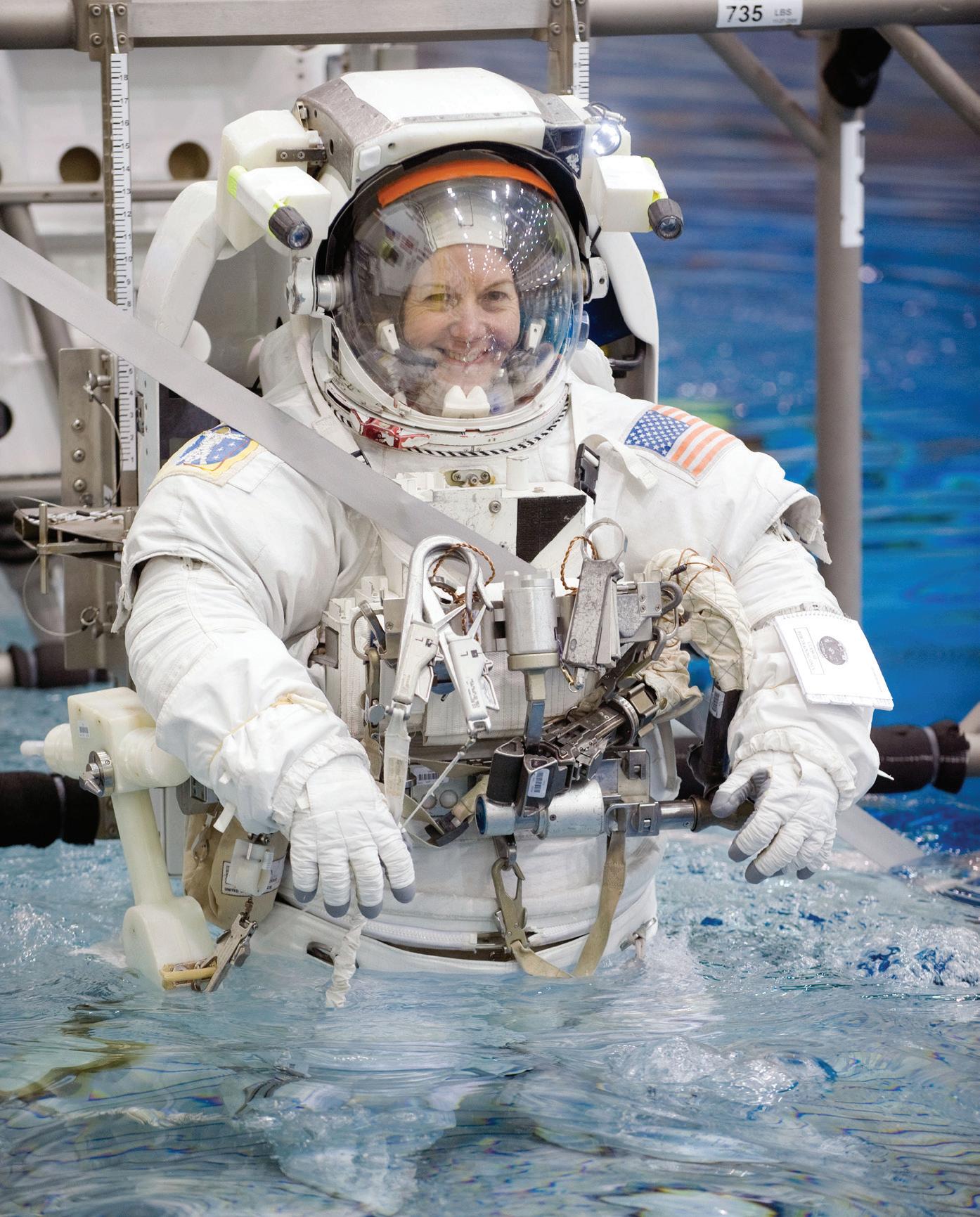
NASA astronaut Cady Coleman, Expedition 26/27 flight engineer, attired in a training version of her Extravehicular Mobility Unit (EMU) spacesuit, is submerged in the waters of the Neutral Buoyancy Laboratory (NBL) near NASA’s Johnson Space Center. The rehearsal in the NBL was intended to help prepare Coleman for work on the exterior of the International Space Station.
This is it. Life aboard the space station is the pinnacle – literally and figuratively – of an astronaut’s or cosmonaut’s career, and it ends too soon: Station missions, called expeditions, typically last about three to six months, with anywhere from three to six crewmembers aboard at all times. American astronaut Scott Kelly and Russian cosmonaut Mikhail Kornienko each spent nearly a year – 342 days – aboard the orbiting laboratory from 2015 to 2016, and astronaut Christina Koch was in orbit for 328 days, from 2019-2020. These months are the most thrilling of crewmembers’ lives – but they’re also somehow comfortingly familiar, resembling common human routines and offering surprising lessons and insights for living on Earth.
THE BODY IN SPACE
Regardless if the astronaut’s mission is a first, or if they have been to space before, many say the microgravity environment of the station takes some getting used to. One of the first things astronauts notice is “fluid shift”: On Earth, gravity pulls body fluids downward; in space, they’re evenly distributed – though it looks and feels as if they’ve rushed to an astronaut’s head. Faces on the space station look puffier, as if they’re hanging upside down; legs are skinnier; stomachs are flatter. Many astronauts experience headaches, and their sinuses feel clogged.

NASA astronaut Scott Kelly (left) and Russian cosmonaut Mikhail Kornienko (right) marked their 300th consecutive day aboard the International Space Station on Jan. 21, 2016. The pair spent a total of 342 days in space on their one-year mission to aid researchers in better understanding how the human body reacts and adapts to long-duration spaceflight.
Some astronauts also experience space sickness, or “Space Adaptation Syndrome.” Michael Barratt, who began his NASA career as an aerospace physician and flight surgeon before joining the astronaut corps, flew aboard the station for Expedition 19/20, in 2009. On the space station, Barratt said, there is no up or down, and the vestibular organs of the inner ear lose their cues. “There is no gravity pulling them down,” he said, “so the signal they send to the brain doesn’t coincide with the motion your body actually makes. Your brain is conflicted. And of course, you don’t feel any weight in your joints.” The most severe symptoms pass after a few days, said Barratt, “and over the next several days to weeks, you transition from being a two-dimensional creature that walks on two legs to a three-dimensional creature that navigates freely in space. And that’s an astounding thing to see.” During this period of adjustment, astronauts learn to move gently and smoothly, with minimal effort, after a period of crashing into things. In an interview with The Washington Post last year, NASA astronaut Mark Vande Hei recalled launching himself to the ceiling simply by tapping a computer keyboard. To prevent too much bouncing around, the interior spaces of the station are equipped with handrails, under which astronauts often hook their feet to secure themselves.
In anticipation of longer-term missions to Mars, Barratt and other space physicians continue to study the way the body adapts to space. Some of these changes appear harmless – the loss of about 15 percent of blood plasma volume in the first few days, for example, because it’s simply not needed – but others, such as a thickening optic nerve, a weaker immune system, and a loss of bone density, create the risk of debilitating short- and longterm consequences for space travelers.

advertisement
Coleman didn’t get sick after boarding the station, but confessed to a brief period of being what she called “space stupid”: She often caught herself gawking at her strange surroundings. “Say you’re reaching to turn on a switch,” she said, “but in the background something is kind of floating, or waving up and down. I think actually it’s a little bit harder to focus, especially on day one, because your brain is trying to process all those things.”
Weightlessness isn’t the only thing that’s different aboard the station. Moving at 17,500 miles an hour (10 times faster than a speeding bullet), the station circles the Earth about every 90 minutes. Behind the thin blue line of Earth’s atmosphere, sunrises flare and sunsets dim with bewildering speed, cycling the station through 45-minute periods of sunlight and darkness. To approximate a normal 24-hour Earth day, the lights aboard the station are dimmed for eight-and-a-half hours of nightly sleep time.

advertisement
In this peculiar environment, astronauts must meet their basic needs as human organisms: They need to sleep, eat, keep clean, and stay fit and healthy. Among these, only one seems to be easier in space: Opinions among station crewmembers vary, but most seem to think microgravity sleep is superior. Today, crewmembers in the U.S. Orbital Segment (USOS) sleep zipped into light sleeping bags, tethered to the wall of one of four phone booth-sized crew quarters in the Harmony (Node 2) module, which connects the American, European, and Japanese laboratories.

European Space Agency (ESA) astronaut Paolo Nespoli, STS-120 mission specialist, rests strapped in his sleeping bag in the Harmony node of the International Space Station in 2007. Today, crewmembers in the U.S. Orbital Segment sleep in sleeping bags tethered in crew quarters.
Don Pettit, a veteran NASA astronaut who has been to the station twice, in 2002-2003 and again in 2011-2012, said: “Sleep was wonderful. All the little aches and pains that accumulate over time on Earth, those just go away, because you don’t have the forces on your body that torque your shoulder around or tweak your neck when you’re sleeping.”

Astronaut C. Michael Foale, Expedition 8 mission commander and NASA ISS science officer, attired in instrumented biking tights, participates in the Foot/Ground Reaction Forces During Spaceflight (FOOT) experiment in the Destiny laboratory on the International Space Station. The Lower Extremity Monitoring Suit (LEMS), the cycling tights outfitted with 20 sensors, measured forces on Foale’s feet and joints and muscle activity while he went about his scheduled activities. Note that Foale’s feet are hooked under a handrail to prevent unintended movement.
Nicole Stott, a retired NASA astronaut who was aboard the station for six months in 2009, arrived with a chronic pain in her arm that went away after a few weeks in space. “That was the best sleep I’ve ever had in my life,” she said. “I would fall asleep and I did not wake up until either an emergency alarm or my watch alarm went off. And I woke up in the exact same position that I’d fallen asleep in.”
Not surprisingly, there’s less agreement about space food. Barratt thought it was fine. “I’m probably not a good one to ask, because I eat everything,” he said. “We have five agencies, and a very strong international influence, and in my first long mission, we had a Japanese, a Belgian, a Canadian, two Russians, and me. So we had food from all of these places. It was an international smorgasbord.”
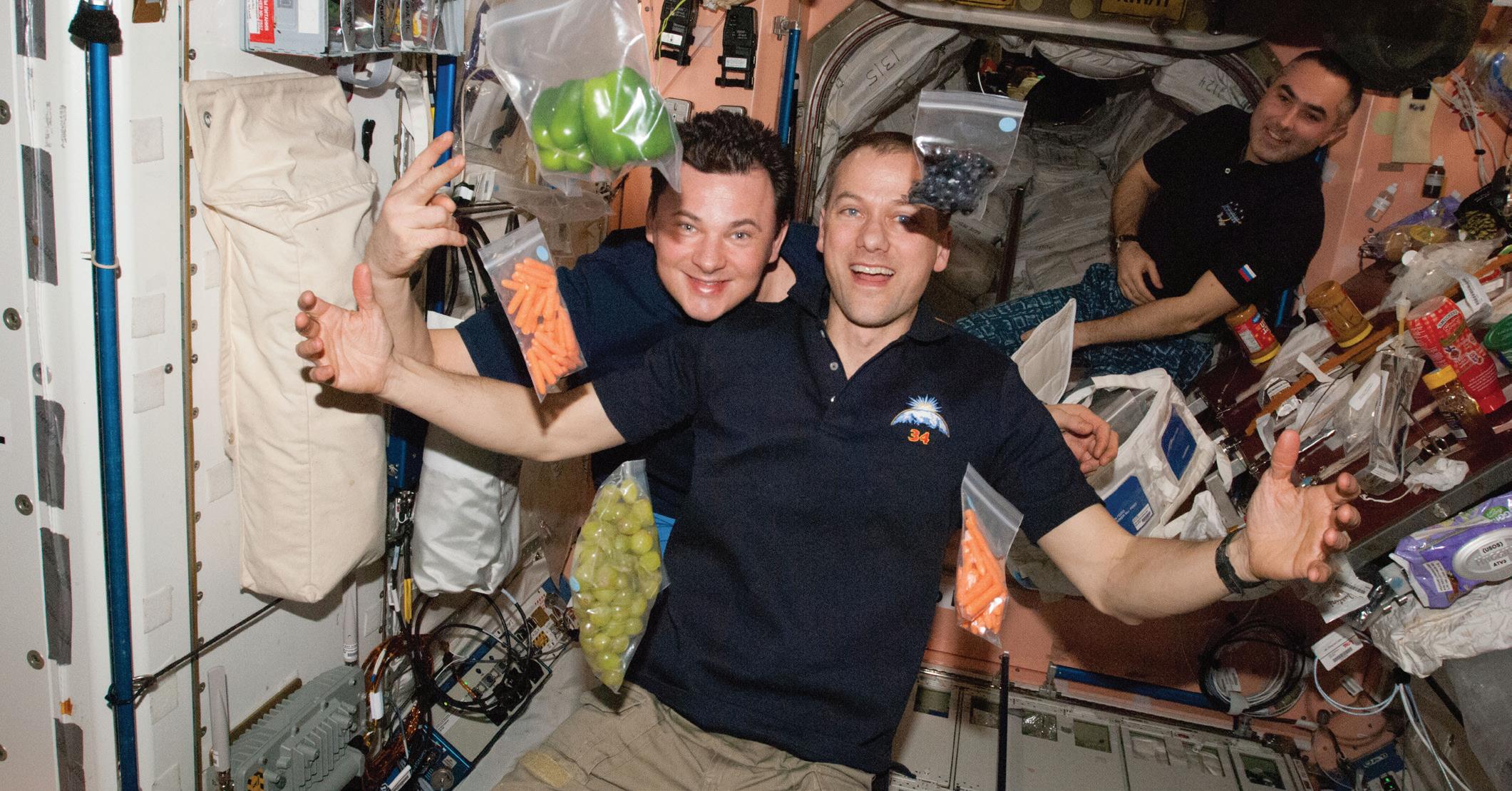
From foreground to aft, Expedition 34 flight engineers Tom Marshburn of NASA and Roman Romanenko and Evgeny Tarelkin of Roscosmos, pictured in the Unity module of the International Space Station in March 2013, can’t hide their delight over the arrival of fresh food and supplies that were delivered by the SpaceX Dragon earlier in the day.
It’s a different kind of smorgasbord, though: vacuum-sealed in spoil-free plastic or foil pouches, often meant to be rehydrated and warmed in an oven. Fresh fruits and vegetables, or the occasional cheese or chocolate, arrive in cargo resupply craft, and are quickly consumed. Some astronauts report difficulty smelling or tasting food, or anything, while others, including Pettit, reported heightened senses, particularly of smell. In his Expedition 6 journals (still accessible on the NASA website), he recalled space itself having a very particular smell, “a rather pleasant sweet metallic sensation” he compared to welding fumes.

NASA astronaut Tim Kopra photographed his breakfast floating inside of the Unity module aboard the International Space Station in April 2016. In a Tweet, he remarked, “#Breakfast taco on #ISS: refried beans, shredded pork, pepperjack cheese, eggs, and salsa on a tortilla. Awesome...”
Rehydrating food – using water for anything, really – presents its own set of challenges. On the space station, water wants to accumulate in floating blobs; the salt and pepper used in space come in liquid form. Rehydrated food, Stott said, often resulted in smelly wet garbage. “We had an agreement as a crew,” she said, “that if you opened something up, you either needed to finish it, so it’s dry, or you need to share it with somebody. Because wet trash is gross.”

advertisement
This agreement was tested on the day astronaut Jeff Williams produced an enormous dill pickle that had been sent from home in a care package. “It was like the ones you see at 7-Eleven,” Stott said, “sealed in its own bag.” It wasn’t the kind of thing normally eaten aboard the station, and Williams and Stott and the other crewmates floated around the table of the Destiny laboratory together, trying to figure out what to do with it. Nobody volunteered to suck all the pickle juice out of the bag, she said, so Williams decided to sop it up with a towel, which he hung up to be dried by the onboard air recirculators. “But oh, my gosh,” Stott said. “The entire station smelled.” Within minutes, she said, Russian cosmonaut Gennady Padalka, his nose crinkled, floated in from the Russian segment. “He said, ‘Jeff, what eez that?’”

advertisement
Astronauts use water to brush their teeth, bathe, and wash their hair, but they use rinsefree soap and shampoo, to avoid wasting water. More than 90 percent of the water used on the station – including sweat, respiration, and even urine – is recycled into drinkable water aboard the USOS. There are two space toilets on the station, in the Russian Zvezda and the U.S. Tranquility modules. Astronauts urinate into an anatomically compatible funnel that feeds directly into the water recycling system. Solid waste is collected in a drum-shaped toilet via vacuum fans, bagged, and transferred to a Russian Progress cargo vehicle, to join other trash that will be incinerated on atmospheric re-entry.

View of the toilet compartment in the Zvezda Service Module of the space station.
WORKING – AND PLAYING – ON THE ORBITING LABORATORY
The space station is primarily a laboratory, and the astronauts are there to work. Every day, astronauts wake between 6:00 and 7:00 UTC (Coordinated Universal Time), eat breakfast, and gather for the Daily Planning Conference to go over the day’s schedule with flight control teams on the ground. A typical workday begins at 8:00 a.m.; the first four hours of the day are spent setting up, performing, and taking down experiments as assigned. There’s a brief lunch break at noon, followed by another five-and-a-half hours of experiment work. The loss of bone density, muscle mass, and cardiovascular efficiency that comes with microgravity requires constant exercise, and sometime within this workday, five to six days a week, each astronaut must exercise for at least two hours using equipment in the Tranquility (Node 3) module: the treadmill (elastic cords, fastened to the waist and shoulder, keep astronauts’ feet in contact with the belt); the stationary cycle (seatless, because there’s no sitting in space); and the Advanced Resistive Exercise Device (ARED), which uses vacuum cylinders to imitate the free weights used on Earth. Cosmonauts use their own treadmill and cycle in the Russian segment, but visit the Tranquility gym to use the ARED.
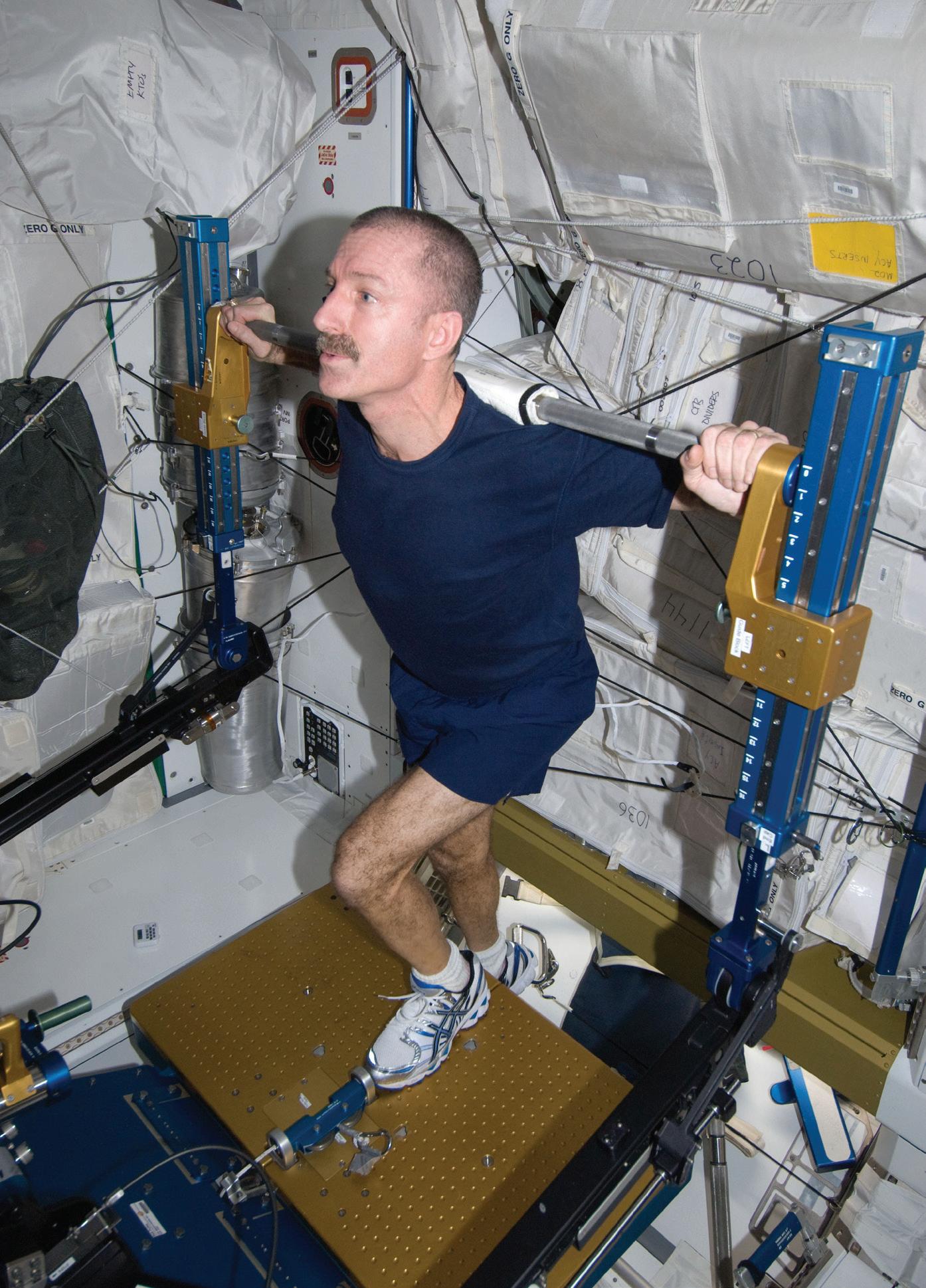
NASA astronaut Dan Burbank, Expedition 30 flight commander, exercises using the Advanced Resistive Exercise Device (ARED) in the Tranquility node of the International Space Station.
Pettit and Barratt, who both served on three- and six-member crews (Barratt, in Expeditions 19 and 20 in 2009, helped oversee the transition from three crewmembers to six), say daily rhythms and the overall feel of the workday changed substantially after the transition. Before 2009, as much as two-thirds of a crewmember’s workday might be spent on activities other than laboratory experiments, like exercise and station maintenance such as monitoring water and air quality, measuring noise levels, or cleaning filters. Once the station transitioned to six crewmembers, Barratt said, “that made a huge difference in the time available to do science.”
The most exciting and challenging work on the space station often involves extravehicular activity – an EVA, or spacewalk, in which crewmembers work in pairs to install, maintain, or repair objects on the station’s exterior. It’s demanding work; every hour spent in an EVA is preceded by several corresponding hours – often weeks’ and months’ worth – of preparation. Every moment of an EVA is scripted and rehearsed, both in virtual reality simulators and the NBL, and merely suiting up for a spacewalk is a painstaking process that often takes up to four hours.

NASA astronaut Peggy Whitson floats through a tangle of cables inside the Columbus module aboard the International Space Station in December 2016 as she operates the Fluids System Servicer to refill coolant loops in multiple modules on the U.S. segment of the station. Since crew sizes increased from three to six in 2009, crewmembers are able to spend less time performing station maintenance and more time working on science.
Not all crewmembers perform spacewalks, and those who do often describe them as their most memorable experiences. In their nearly seven-hour EVA on Sept. 1, 2009, Stott and John “Danny” Olivas removed an empty ammonia tank from the station’s truss and moved two experiments (the materials processing experiment, or MISSE, and the European Technology Exposure Facility, or EuTEF) from the exterior of the Columbus laboratory to the cargo bay of the shuttle Discovery. Stott confesses to not remembering a lot of details from those seven hours – “it’s like a blur,” she said, “one of the most surreal things I’ve ever done” – but a few stand out vividly, including the moment she exited the airlock. “You come out and you’re thinking: Oh, my gosh, the Earth really is 250 miles down. There is no bottom of the pool or crew of divers around you.” After getting over the initial shock of floating free in space, Stott also found that despite her hours of simulation and preparation, an EVA always involves some on-the-job training. “Some of the cues that I had built into my muscle memory for how I was going to move from the airlock to my first worksite were things in the pool, like cables that hung down that I had to get underneath and around. And in space they weren’t there,” she said.
No Western astronaut has spent more time spacewalking than Michael López-Alegría, who performed five EVAs during Expedition 14 (2006-2007), during which he was the station commander. He conducted five other EVAs during space shuttle flights in 2000 and 2002 – for a total of 67 hours and 40 minutes, most of them spent assembling the station. His most technically difficult EVAs, he said, would be preceded by seven to 10 run-throughs in the NBL. “That of course doesn’t include all the training that you go through just to get to that point,” he said. “To get assigned and EVA proficient, there is a lot of training.”

NASA astronaut Nicole Stott, Expedition 20 flight engineer, pictured during the STS-128 mission’s first session of extravehicular activity (EVA) on Sept. 1, 2009. Stott participated in the six-hour, 35-minute spacewalk with astronaut John “Danny” Olivas (out of frame).
According to López-Alegría, who retired from NASA in 2012, every spacewalk introduces little surprises. “In space, nothing goes exactly as planned,” he said. “There are always sticky connectors, and thermal blankets are challenging. Everything is a little bit harder in space, with the exception of moving around.”
During Expedition 20, Barratt performed a five-hour EVA with Padalka, preparing the Zvezda service module for the arrival of the Poisk module (Mini-Research Module 2, or MRM2). The pair also performed an IVA – an intra-vehicular activity – in the depressurized Zvezda. He replaced the module’s hatch with a docking cone to receive the Poisk on its arrival. “I think they expected us to take 45 minutes,” he said. “And we did it in 12 lousy minutes.” He felt a gut-punch of disappointment when he opened the hatch and saw the unattainable circle of space, just in front of him: “I think we were on the dark side, because I could see stars,” he said. “And every cell in my body wanted to go outside.”
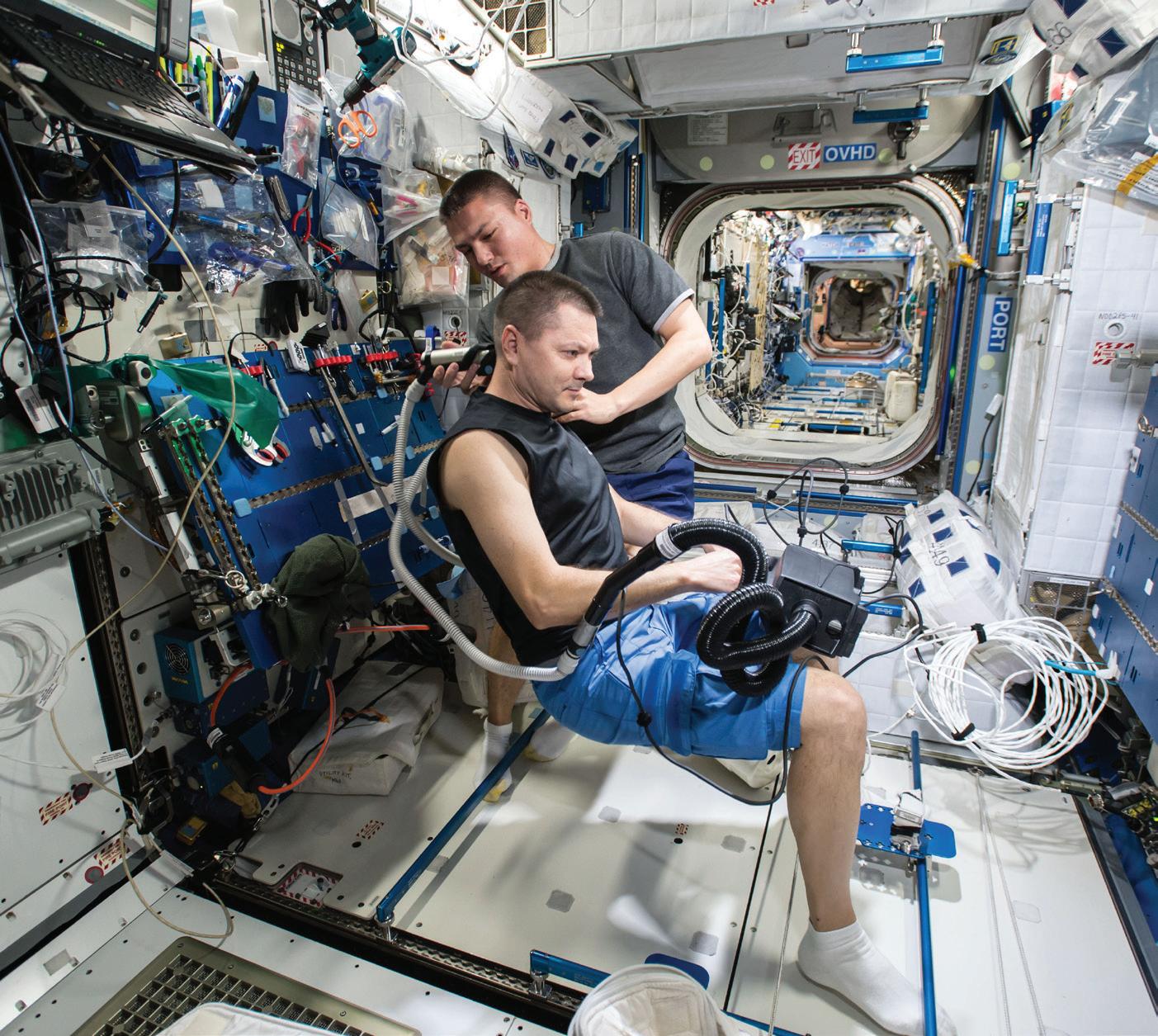
Inside the station’s Harmony module in September 2015, NASA astronaut Kjell Lindgren (back) gives Russian cosmonaut Oleg Kononenko (front) a haircut using a special set of clippers with a vacuum attachment to collect loose hairs in microgravity. Astronaut-cosmonaut interaction was a given in the space station’s early years, when the structure was smaller, but today the level of interaction often depends on the crew.
Barratt’s EVA, in the Russian segment, was commanded from Moscow. He wore a Russian Orlan spacesuit and communicated with Padalka and the ground crew in Russian. This is a little-known fact about astronauts assigned to the USOS: They must all learn to speak Russian, one of the station’s two working languages.
Understanding Russian also helps to build fellowship among a crew that is usually at least one-third Russian. Cosmonaut/astronaut interaction was a fact of life during the early years of the space station, when both the station and crew were smaller. Now that both are larger and more dispersed, living and working in their respective spaces in a structure the size of a six-bedroom house, the level of interaction often depends on the crew.
“We had one of the best crews,” Barratt said. All six ate lunch together in the Russian segment and dinner in the U.S. segment, nearly every day, for 199 days. “One person was designated to bring the iPod to the table with music,” he said. “If Roman Yurievich Romanenko, on the Russian side, brought it, you knew you were going to listen to heavy metal. And if I brought it, it was going to be Celtic rock.”
While crewmembers are typically separated during the workday, performing their respective tasks in the Russian and U.S. Orbital segments, there is ample opportunity in the evenings, and on Saturdays (when there’s a half workday) and Sundays – when, said LópezAlegría, “Everybody does their own thing. Some people spend a lot of time on the phone. Some people read. Some people watch movies. Some just look out the window ... We also had something called the task list, or job jar, kind of low-priority stuff that didn’t get scheduled during the week that we could do if we had the ambition.”
Astronauts spend a good amount of their free time connecting with friends and family back home, via audio or video calls, email, or social media. Barratt, who is married with five children, spoke to his wife every day, and was often able to help his teenage kids with their homework. “We were a pretty close family at the start, and that’s really what made it all possible,” he said. “It’s hard on families, make no mistake.” Coleman’s crewmate, the Italian astronaut Paolo Nespoli, lost his mother to cancer while he was on the station, which left the rest of the crew wondering how to comfort him and help him through his grief. “I think it takes a certain generosity, on the part of the crewmate who has suffered that loss – whether they want their crewmates’ support or not – to make their crewmates feel comfortable with what they’re going through,” said Coleman. “Paolo really did that for us. We ended up observing his mom’s funeral together from the cupola window, at the same time the funeral was happening on the Earth.”
Coleman, an avid flautist, took four instruments to the station: her own flute, an antique flute and tin whistle belonging to Matt Molloy and Paddy Moloney of the Irish band The Chieftains, and a flute from Ian Anderson of the rock group Jethro Tull. She played each aboard the station, including the first space/ Earth duet, which she performed with Anderson – coincidentally, on the 50th anniversary of Yuri Gagarin’s launch. Back on Earth, Coleman continues to play with Bandella, the group that made its name playing bluegrass, jazz, and folk-rock at a sandwich shop/roadhouse near the Johnson Space Center. Led by space-guitar god Chris Hadfield, the retired Canadian astronaut whose station-staged cover of David Bowie’s “Space Oddity” so far has logged more than 47 million YouTube views, the band also features Coleman, retired NASA astronaut Steve Robinson (guitar, banjo, stand-up bass), Micki Pettit (the vocalist and Don Pettit’s wife), and their longtime friend Dave Webb (keyboards).

Nicole Stott is the first astronaut to have painted what she saw from the space station with watercolors.
Stott was responsible for another space station “first”: She took a set of watercolors and became the first astronaut to paint what she saw from the station window – the turquoise seas swirling around Los Roques, a chain of islands off the Venezuelan coast. Learning how to paint with water in microgravity was its own struggle, a story she’s told in writing and interviews. Stott has since combined her loves of art and space into the Space for Art Foundation, which connects children in hospitals, refugee centers, and schools around the world.
There’s nothing special or quirky about playing a musical instrument or painting in space, Stott said; music and art have been in space for as long as people have been there. Given free time, people do what they love and express themselves in deeply personal ways. The world’s first spacewalker, Alexei Leonov, drew colored-pencil sketches of the view from his Voskhod 2 capsule in March 1965. NASA astronaut Karen Nyberg (now retired) pieced together quilt blocks aboard the station. NASA astronaut Kjell Lindgren played the bagpipes.
“We’re not just working there,” said Stott. “We live there. If you aren’t a photographer before you get to space, you become one, because you want your face in front of that window and you want to remember it and share it with everyone. You want to put the ‘human’ in human spaceflight.”
EARTH’S POWERFUL PULL
Stott’s urge to share what she saw from the orbiting laboratory springs from a desire to make more people aware of it. It’s often right above us, the second-brightest object in the night sky, hurtling overhead, and while there are plenty of tools to pinpoint it – including NASA’s own Spot the Station (http://spotthestation.nasa.gov) or smartphone apps – most terrestrials remain oblivious. Stott’s husband often jokes that ISS stands for “Invisible Space Station” – “and that crushes me every time I hear that. But it’s true. It’s like this unseen masterpiece,” she said. “I use art to share the experience, and to tell the story of how we’ve been working peacefully and successfully, these 15 different countries, for 20 years now – and just what a wonderful example that is of how we should be living like crew down here on Spaceship Earth.”
Many crewmembers describe their time aboard the space station as a surprisingly Earth-oriented existence, for one that happens 250 miles above the planet. During the serene 25 minutes Stott rode the station’s robotic arm, guiding the bulky EuTEF into Discovery’s cargo bay, she said, she realized she was the farthest human being from the Earth. “But I felt so connected, as well, to everybody down on the planet below me, to my crewmembers inside, to the people in Mission Control.”
In March 2011, when an earthquake and tsunami struck the coast of Japan, the country’s space agency, JAXA, was forced to evacuate its control center in Tsukuba. According to Coleman, who was on the station that day, the crew became intently focused on waking at night, as the station passed over Japan, to see it and send images that might help the country understand the scope of the disaster: where the damage was and which areas had power. “It was really a way for us to say: ‘We see you. We know you’re there,’” Coleman said.

From 220 miles above Japan, an Expedition 26 crewmember onboard the International Space Station took this 200 mm view of the Sendai coast and southward on March 14, 2011, three days after the one-two punch of an earthquake followed by a tsunami. Crewmembers hoped to help the country understand the scope of the disaster by sending images of the affected area taken from the station.
Those with an eye to future space travel see these forces – both gravitational and emotional – as a mixed blessing. López-Alegría, who operates his own space consultancy, MLA Space, and is a vice president of the private aerospace company Axiom Space, sees it as a problem to be solved. The joy and magnificence of his space adventures were always couched in the knowledge that he would soon return to Earth. “It was an adventure. It was an experience. It was a dream come true,” he said. “But I’m not the guy who wants to go colonize space and not come back.” On the space station, he could call anyone he wanted, and he could go to the nearest window and see Earth anytime. “But when we start going to Mars,” he said, “I think that’s going to be very difficult. You can’t talk [to Earth] in real time.
You probably can’t see Earth – and if you can, it’s just one of many points of light out there in the black. I think it’s going to be a very, very different experience, and I don’t know how we prepare for that.”
Don Pettit – who is helping NASA envision the lunar lander it hopes will be on the Moon by 2024 – seems ready to go right now. Venturing beyond low-Earth orbit, he said, will probably be hard, but in the way that embarking for the New World was hard for a generation of explorers and immigrants seeking something new and different. As an Expedition 6 science officer, Pettit was already anticipating life in space would alter the very minds of human beings, and introduce an era of explosive innovation and cultural change.
“You see that story played out time and again as humanity spread across the Earth, and I think that story will repeat when we move more people off the planet,” said Pettit. “They’ll stay in the orbital environment, and they’ll move to planetary surfaces like the Moon and Mars. And as you have people growing up and living and working there, there will be things in those environments that will excite our thoughts into directions that nobody on Earth would have ever thought of – however, once you make these discoveries, once you make a paradigm shift, everybody on Earth will be able to understand.”
It’s telling that someone as outward-looking as Pettit, when rhapsodizing about the innovations to come, can’t help but imagine how future lives in space will transform the way we live on our home planet.
“We are all Earthlings,” Stott said. “The only border that matters is that thin blue line – and every single thing we do up there is ultimately about improving life here on Earth.”










